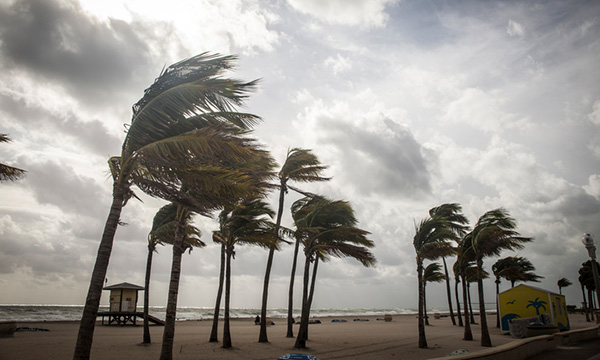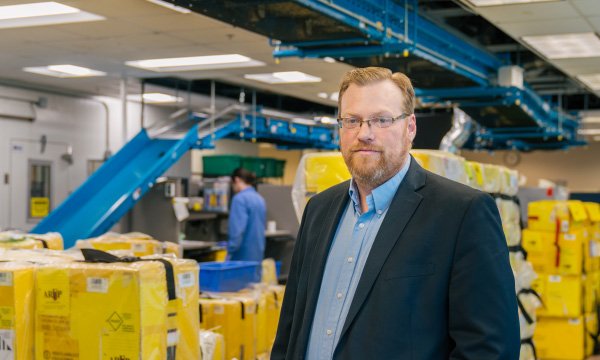
ARUP Laboratories’ Transportation department is tasked with safe delivery of 50,000 specimens to the lab and into processing each day, from 50 percent of the nation’s university medical centers, pediatric hospitals, and teaching hospitals. That involves planning for weather (such as hurricanes and tropical storms) and other delays, and taking quick action.
Pope Francis was visiting Philadelphia’s narrow, colonial streets. It was a busy occasion for the city and also a puzzle for an ARUP courier to solve. The goal: get in, get out, deliver cargo to the next Delta airline flight headed to Salt Lake City. Specimens were on the plane and packed to protect viability, each connected to the life of a patient.
“Our mission is to try to get those specimens from the client's hands as quickly as possible,” says Christopher Sorensen, National Transportation manager, ARUP. “We do whatever it takes.”
ARUP’s nation-wide Transportation system has to adapt quickly to unexpected events and phenomena: hurricanes, wildfires, blizzards, floods, labor strikes. They had to adjust in America’s sixth-largest city in 2017, when the papal visit shut down dozens of city blocks—and other times, for quickly escalating hurricanes; wildfires that surrounded towns; and Jonas, the East Coast blizzard.
“We’re not just widgets and parts; our freight contains human lives,” says Sorensen. “We thrive on the excitement of working on something that has to be done immediately, urgently. It is why many of us do what we do.”
In order to anticipate changing elements, airport snarls, and distance, ARUP sets up many processes early, says Sorensen. After all, the department is tasked with safe delivery of 50,000 specimens to the lab and into processing each day, from 50 percent of the nation’s university medical centers, pediatric hospitals, and teaching hospitals. Here’s how they work that out.
PLANNING
- The Transportation department fosters relationships with couriers in all busy hubs of travel where planes could be slowed or shut down (particularly Dallas, Atlanta, Chicago, and Phoenix).
- They explain the importance of their work (transporting human specimens, affecting human lives) in advance to couriers, FedEx, and others.
- ARUP monitors its shipments 24/7 to make sure they're traveling effectively. That surveillance covers conditions and shipments throughout the country, with individuals—regional specialists—watching the eastern, central, and western regions.
- The Transportation department subscribes to National Weather Service alerts for hurricanes, blizzards, and anything else that could influence flights or access to a pickup site. They also pay for a service that feeds into ARUP’s home airport, so that arriving flights can be seen.
- FedEx provides a feed to Transportation, showing that shipper’s weather alert system for its hubs, which the department reads every day.
- Transportation keeps letters on hand from ARUP executives about the critical effect of the lab’s work on human lives, so that Transportation can put those into the hands of couriers in the case of a labor strike that locks down traffic in an area.
- ARUP is also able to search clients by airport codes when certain airports are anticipated to shut down (because of a slow-moving hurricane or other predictable event) and work out alternative routes in advance.
- While ARUP has historically done a very good job of getting shipments through, says Sorensen, now that regional specialists watch the nation’s three areas, it’s especially possible to send advance word of any delay or traffic snarl to account executives, who can speak with customers in that area. “We're focusing now on being interactive with clients to let them know where their specimen is,” says Sorensen. “They hand the specimen over to the courier and their part is done, but their investment doesn't stop. They still care, and they still have patients at their facilities waiting for treatment.”

WHAT MAKES THE DIFFERENCE
It doesn’t hurt that Transportation is a group of people who have gravitated toward the role, and that the staff has a little extra oomph. “We’re not just widgets and parts; our freight contains human lives,” says Sorensen. “We thrive on the excitement of working on something that has to be done immediately, urgently. It is why many of us do what we do.”
Catherine Arnold, Science Communications Writer
Related blog:
“Journey of a Specimen, Transportation: #1 of Our 6-Part Video Blog”
















